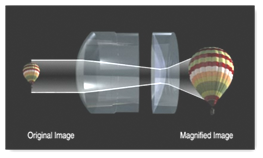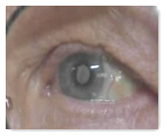The device is for advanced macular degeneration, which is mostly going to be seniors as it is related to age. A cataract surgeon is the doctor who does the implant.  The device is not a cure but rather restores sight back to where it was before AMD began and will not completely correct vision 100% but will improve it.
The device is not a cure but rather restores sight back to where it was before AMD began and will not completely correct vision 100% but will improve it.
The website has a couple patient stories/video you can read and watch here. The one eye without the telescope is used for peripheral vision and it requires a little time to get used to using one eye just for that purpose.
The telescope is not even visible and glasses are required. The eye with the telescope is used for central vision. This looks very cool and can offer some vision alternative solutions for those with AMD. The implant is the size of a pea. This is totally fascinating technology. BD
From the website:
“The telescope implantation surgical procedure is performed on only one eye. It involves removing the eye's natural lens and replacing it with a tiny telescope  implant. This part of the treatment process is done in a relatively short outpatient surgery by a specially trained ophthalmologist who performs cornea and cataract surgeries (cornea/cataract surgeon). You won't have to stay in a hospital and will return home the same day.
implant. This part of the treatment process is done in a relatively short outpatient surgery by a specially trained ophthalmologist who performs cornea and cataract surgeries (cornea/cataract surgeon). You won't have to stay in a hospital and will return home the same day.
The surgery involves several steps:
- Your eye will be numbed at the beginning of the procedure so you will not feel any pain
- Special eye drops will be administered to temporarily enlarge your pupil
- Your eye will be held open with a special instrument called a lid speculum, and an operating microscope will be placed in front of your eye
- The surgeon will remove you eye's natural lens
- The telescope prosthesis will be placed in the same position where the natural lens was located
- The surgical incision will be sutured closed
The surgical procedure will take approximately 1 hour.
If there are complications during your surgery, your surgeon may not be able to finish the procedure. This means that you may undergo surgery, but not be able to receive the telescope implant and the potential benefits you could gain with it. If this is the case, your surgeon will attempt to implant a standard intraocular lens (IOL), as in any procedure for cataract removal.
Before the surgery, be sure to discuss any questions you might have with your surgeon. After surgery, you will have follow-up visits with your surgeon and eye  drops to take for several weeks.”
drops to take for several weeks.”
WASHINGTON — U.S. health officials have approved a first-of-its-kind technology to counter a leading cause of blindness in older adults — a tiny telescope implanted inside the eye.
The Implantable Miniature Telescope aims to help in the end stages of incurable age-related macular degeneration, a creeping loss of central vision that blocks reading, watching TV, eventually even recognizing faces.
The idea: Surgically insert the Implantable Miniature Telescope into one eye for better central vision, while leaving the other eye alone to provide peripheral vision. The brain must fuse two views into a single image, and the Food and Drug Administration warned Tuesday that patients need post-surgery rehabilitation to make it work.
The Associated Press: FDA clears first implantable telescope for vision
